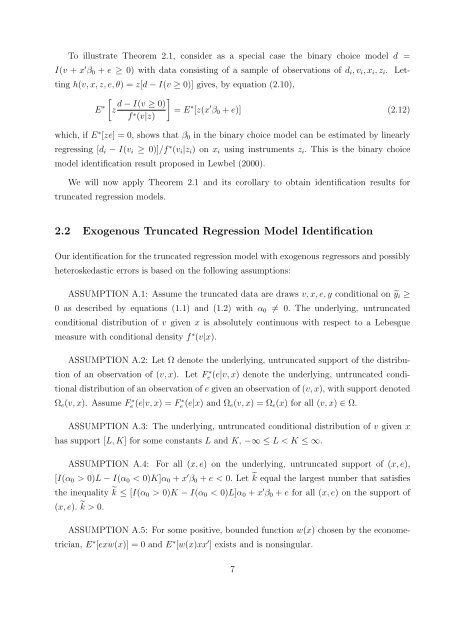weighted and two stage least squares estimation of ... - Boston College
weighted and two stage least squares estimation of ... - Boston College
weighted and two stage least squares estimation of ... - Boston College
Create successful ePaper yourself
Turn your PDF publications into a flip-book with our unique Google optimized e-Paper software.
To illustrate Theorem 2.1, consider as a special case the binary choice model d =<br />
I(v + x ′ β0 + e ≥ 0) with data consisting <strong>of</strong> a sample <strong>of</strong> observations <strong>of</strong> di, vi, xi, zi. Let-<br />
ting h(v, x, z, e, θ) = z[d − I(v ≥ 0)] gives, by equation (2.10),<br />
E ∗<br />
<br />
d − I(v ≥ 0)<br />
z<br />
f ∗ <br />
= E<br />
(v|z)<br />
∗ [z(x ′ β0 + e)] (2.12)<br />
which, if E ∗ [ze] = 0, shows that β0 in the binary choice model can be estimated by linearly<br />
regressing [di − I(vi ≥ 0)]/f ∗ (vi|zi) on xi using instruments zi. This is the binary choice<br />
model identification result proposed in Lewbel (2000).<br />
We will now apply Theorem 2.1 <strong>and</strong> its corollary to obtain identification results for<br />
truncated regression models.<br />
2.2 Exogenous Truncated Regression Model Identification<br />
Our identification for the truncated regression model with exogenous regressors <strong>and</strong> possibly<br />
heteroskedastic errors is based on the following assumptions:<br />
ASSUMPTION A.1: Assume the truncated data are draws v, x, e, y conditional on yi ≥<br />
0 as described by equations (1.1) <strong>and</strong> (1.2) with α0 = 0. The underlying, untruncated<br />
conditional distribution <strong>of</strong> v given x is absolutely continuous with respect to a Lebesgue<br />
measure with conditional density f ∗ (v|x).<br />
ASSUMPTION A.2: Let Ω denote the underlying, untruncated support <strong>of</strong> the distribu-<br />
tion <strong>of</strong> an observation <strong>of</strong> (v, x). Let F ∗ e (e|v, x) denote the underlying, untruncated condi-<br />
tional distribution <strong>of</strong> an observation <strong>of</strong> e given an observation <strong>of</strong> (v, x), with support denoted<br />
Ωe(v, x). Assume F ∗ e (e|v, x) = F ∗ e (e|x) <strong>and</strong> Ωe(v, x) = Ωe(x) for all (v, x) ∈ Ω.<br />
ASSUMPTION A.3: The underlying, untruncated conditional distribution <strong>of</strong> v given x<br />
has support [L, K] for some constants L <strong>and</strong> K, −∞ ≤ L < K ≤ ∞.<br />
ASSUMPTION A.4: For all (x, e) on the underlying, untruncated support <strong>of</strong> (x, e),<br />
[I(α0 > 0)L − I(α0 < 0)K]α0 + x ′ β0 + e < 0. Let k equal the largest number that satisfies<br />
the inequality k ≤ [I(α0 > 0)K − I(α0 < 0)L]α0 + x ′ β0 + e for all (x, e) on the support <strong>of</strong><br />
(x, e). k > 0.<br />
ASSUMPTION A.5: For some positive, bounded function w(x) chosen by the econome-<br />
trician, E ∗ [exw(x)] = 0 <strong>and</strong> E ∗ [w(x)xx ′ ] exists <strong>and</strong> is nonsingular.<br />
7

















